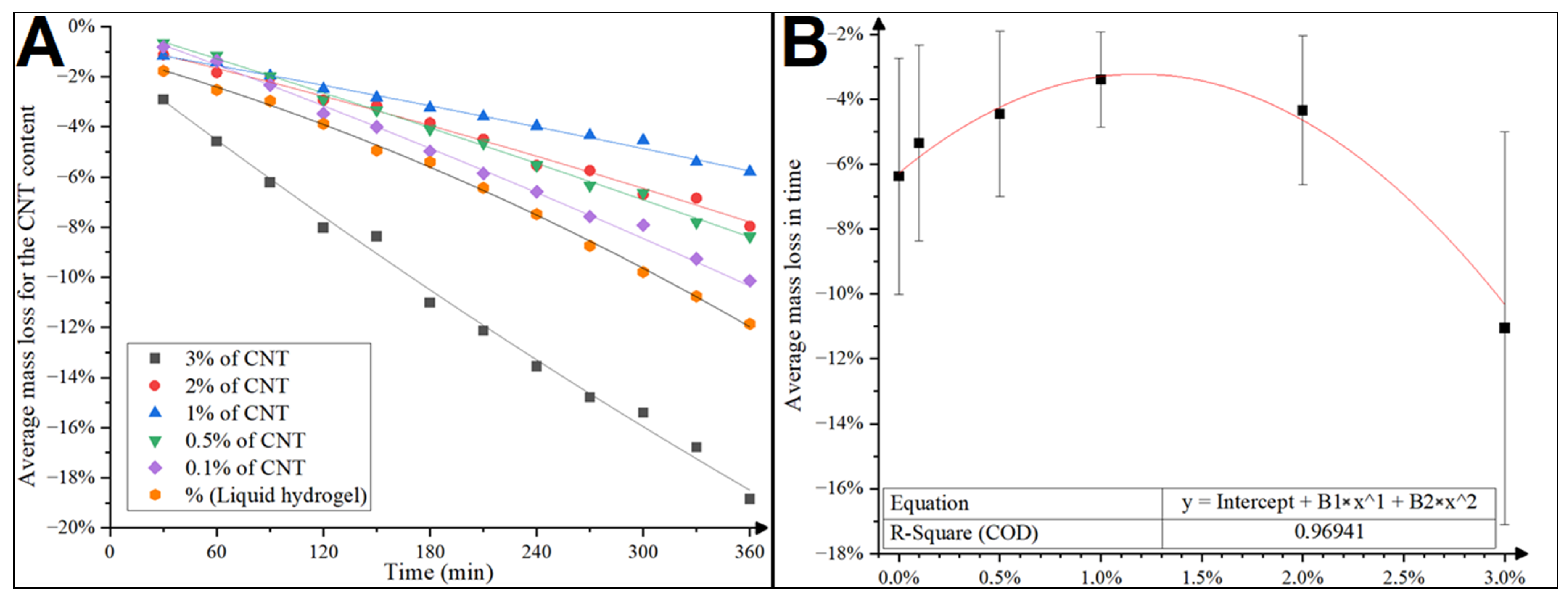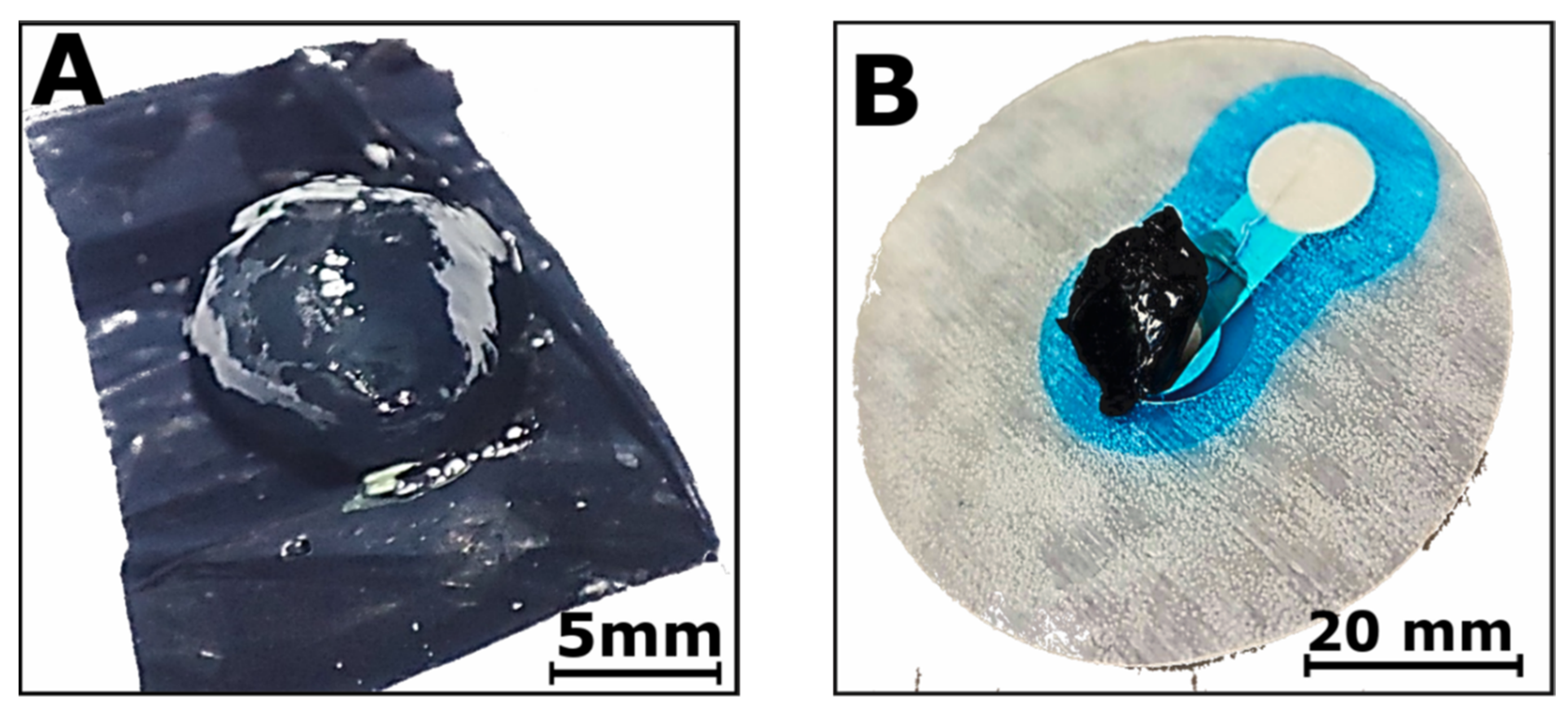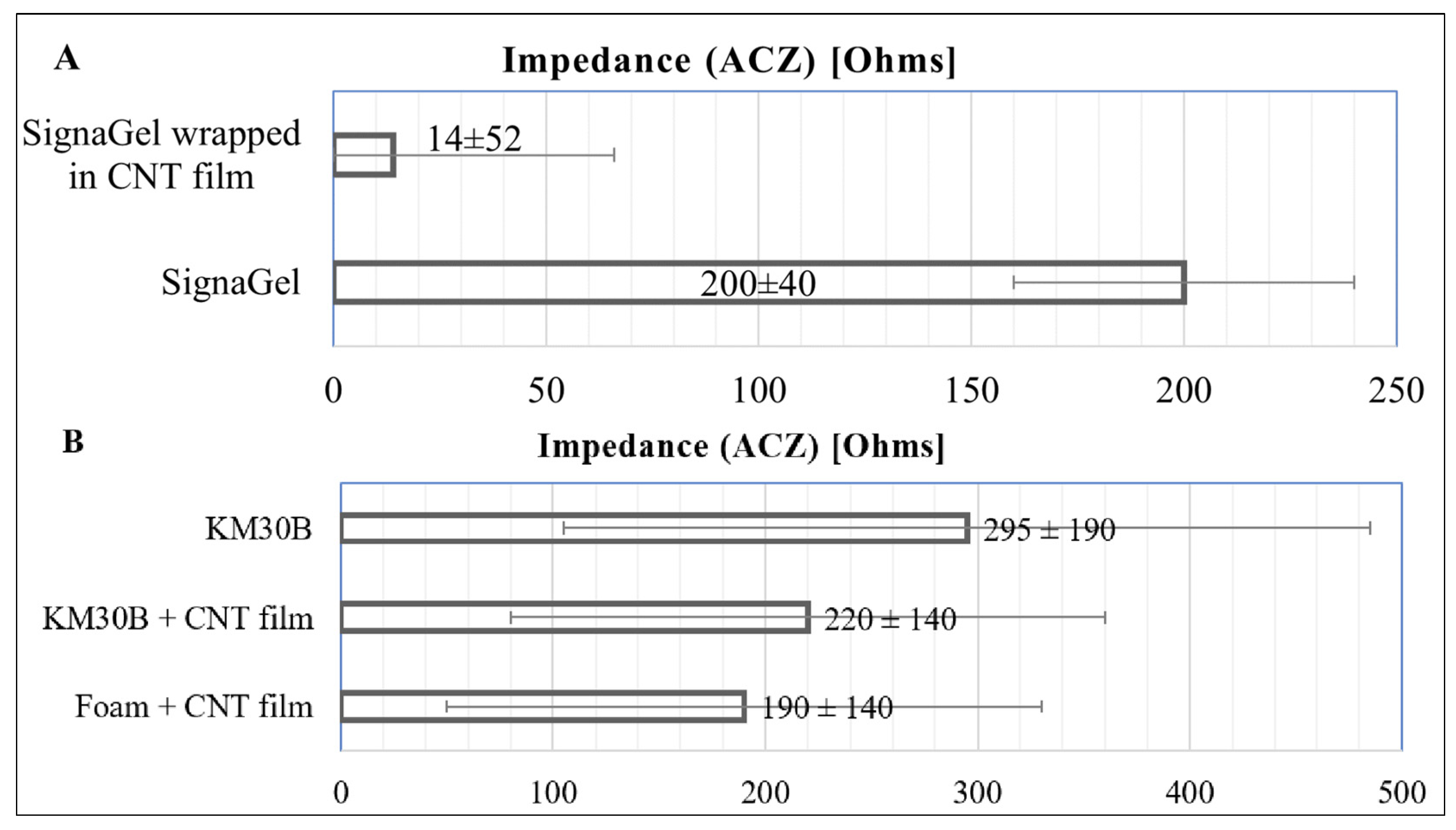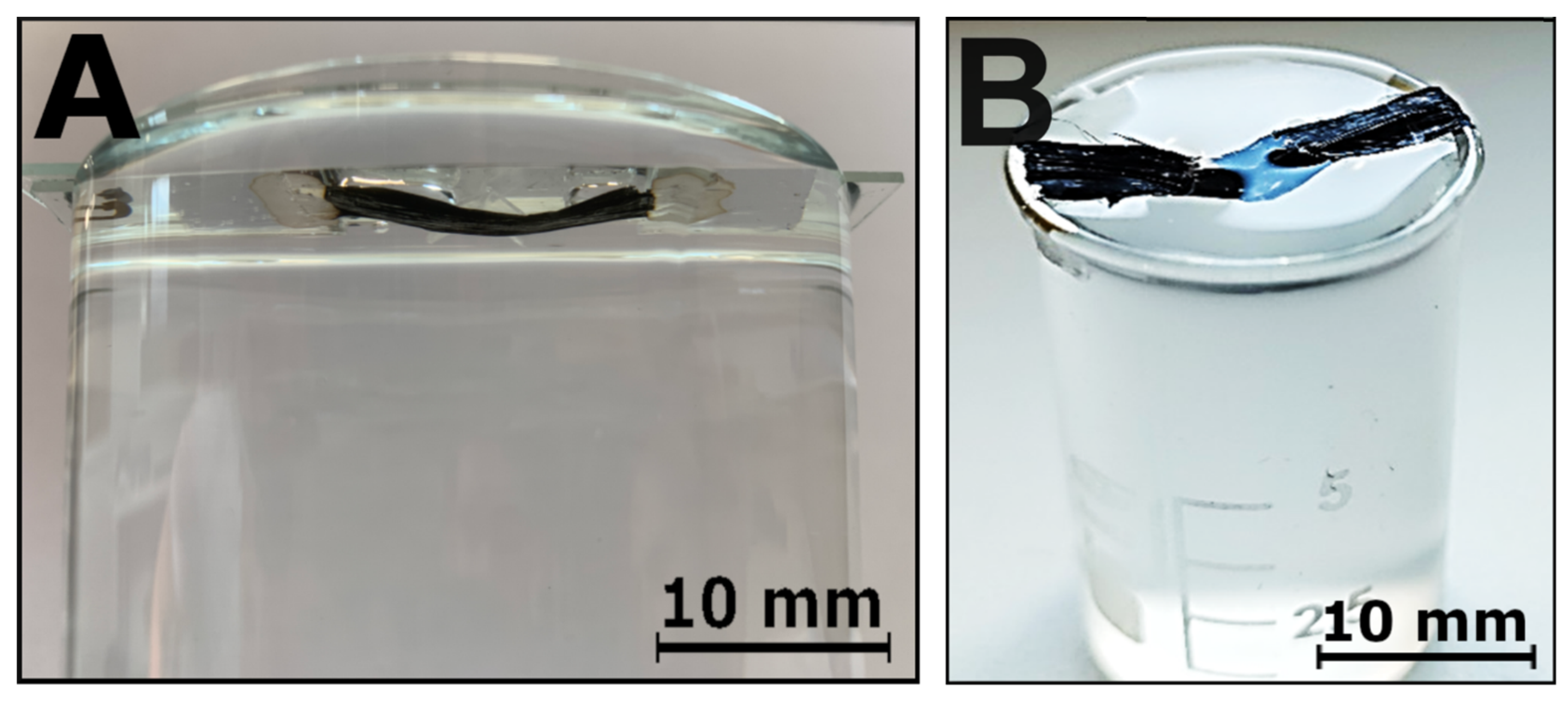Hydrogels and Carbon Nanotubes: Composite Electrode Materials for Long-Term Electrocardiography Monitoring
Abstract
:1. Introduction
2. Results and Discussion
2.1. Hydrogels Selection
2.2. Hybrid Hydrogels Produced by Mixing with CNTs
2.3. Hybrid Hydrogels Manufactured by Wrapping Structures in CNT Film
2.4. Model of Electrical Conduction of the Wrapped Hybrid CNT Hydrogel
3. Materials and Methods
3.1. Materials
3.2. Preparation of CNT Screen-Printed Paths
3.3. Preparation of Hybrid Hydrogels Reference Electrodes
3.4. Characterization of Composite Materials and Electrodes
3.5. The Statistical Analysis
4. Conclusions
Supplementary Materials
Author Contributions
Funding
Institutional Review Board Statement
Informed Consent Statement
Data Availability Statement
Conflicts of Interest
References
- Shay, T.W. Hydrogel and Microfluidic Enabling Technologies for Wearable Biomonitoring Devices: Sweat and ECG Sensing; North Carolina State University: Raleigh, NC, USA, 2017; ISBN 0355458861. [Google Scholar]
- Zhao, J.; Sclabassi, R.J.; Sun, M. Biopotential electrodes based on hydrogel. In Proceedings of the IEEE 31st Annual Northeast Bioengineering Conference, Hoboken, NJ, USA, 2–3 April 2005; pp. 69–70, ISBN 2160-7028. [Google Scholar]
- American National Standards Institute. ANSI/AAMI EC12:2000 (R2020): Disposable ECG Electrodes; Association for the Advancement of Medical Instrumentation (AAMI): Arlington, VA, USA, 2020. [Google Scholar]
- Ochocki, M.; Latos, S. Influence of defibrillation treatment on some electrical parameters and application safety of ECG electrodes. J. Med. Inform. Technol. 2012, 19, 133–139. [Google Scholar]
- Yao, S.; Zhu, Y. Nanomaterial-enabled dry electrodes for electrophysiological sensing: A review. JOM 2016, 68, 1145–1155. [Google Scholar] [CrossRef]
- Baek, J.-Y.; An, J.-H.; Choi, J.-M.; Park, K.-S.; Lee, S.-H. Flexible polymeric dry electrodes for the long-term monitoring of ECG. Sens. Actuators A Phys. 2008, 143, 423–429. [Google Scholar] [CrossRef]
- Chlaihawi, A.A.; Narakathu, B.B.; Emamian, S.; Bazuin, B.J.; Atashbar, M.Z. Development of printed and flexible dry ECG electrodes. Sens. Bio-Sens. Res. 2018, 20, 9–15. [Google Scholar] [CrossRef]
- Jung, H.; Moon, J.; Baek, D.; Lee, J.; Choi, Y.; Hong, J.; Lee, S. CNT/PDMS Composite Flexible Dry Electrodesfor Long-Term ECG Monitoring. IEEE Trans. Biomed. Eng. 2012, 59, 1472–1479. [Google Scholar] [CrossRef]
- Abu-Saude, M.; Morshed, B.I. Characterization of a Novel Polypyrrole (PPy) Conductive Polymer Coated Patterned Vertical CNT (pvCNT) Dry ECG Electrode. Chemosensors 2018, 6, 27. [Google Scholar] [CrossRef]
- Yapici, M.K.; Alkhidir, T.; Samad, Y.A.; Liao, K. Graphene-clad textile electrodes for electrocardiogram monitoring. Sens. Actuators B Chem. 2015, 221, 1469–1474. [Google Scholar] [CrossRef]
- Fink, P.L.; Muhammad Sayem, A.S.; Teay, S.H.; Ahmad, F.; Shahariar, H.; Albarbar, A. Development and wearer trial of ECG-garment with textile-based dry electrodes. Sens. Actuators A Phys. 2021, 328, 112784. [Google Scholar] [CrossRef]
- Ruffini, G.; Dunne, S.; Fuentemilla, L.; Grau, C.; Farres, E.; Marco-Pallarés, J.; Watts, P.C.; Silva, S.R. First human trials of a dry electrophysiology sensor using a carbon nanotube array interface. Sens. Actuators A Phys. 2008, 144, 275–279. [Google Scholar] [CrossRef]
- Gandhi, B.; Raghava, N.S. Fabrication techniques for carbon nanotubes based ECG electrodes: A review. IETE J. Res. 2020, 1–20. [Google Scholar] [CrossRef]
- Srivastava, A.K.; Bhartia, B.; Mukhopadhyay, K.; Sharma, A. Long term biopotential recording by body conformable photolithography fabricated low cost polymeric microneedle arrays. Sens. Actuators A Phys. 2015, 236, 164–172. [Google Scholar] [CrossRef]
- Salvo, P.; Raedt, R.; Carrette, E.; Schaubroeck, D.; Vanfleteren, J.; Cardon, L. A 3D printed dry electrode for ECG/EEG recording. Sens. Actuators A Phys. 2012, 174, 96–102. [Google Scholar] [CrossRef]
- Kim, T.; Park, J.; Sohn, J.; Cho, D.; Jeon, S. Bioinspired, highly stretchable, and conductive dry adhesives based on 1D–2D hybrid carbon nanocomposites for all-in-one ECG electrodes. ACS Nano 2016, 10, 4770–4778. [Google Scholar] [CrossRef]
- Grimnes, S. Skin impedance and electro-osmosis in the human epidermis. Med. Biol. Eng. Comput. 1983, 21, 739–749. [Google Scholar] [CrossRef]
- Jung, J.; Shin, S.; Kim, Y.T. Dry electrode made from carbon nanotubes for continuous recording of bio-signals. Microelectron. Eng. 2019, 203, 25–30. [Google Scholar] [CrossRef]
- Lee, J.H.; Nam, Y.W.; Jung, H.-C.; Baek, D.-H.; Lee, S.-H.; Hong, J.S. Shear induced CNT/PDMS conducting thin film for electrode cardiogram (ECG) electrode. BioChip J. 2012, 6, 91–98. [Google Scholar] [CrossRef]
- Liu, B.; Luo, Z.; Zhang, W.; Tu, Q.; Jin, X. Carbon nanotube-based self-adhesive polymer electrodes for wireless long-term recording of electrocardiogram signals. J. Biomater. Sci. Polym. Ed. 2016, 27, 1899–1908. [Google Scholar] [CrossRef]
- Abu-Saude, M.J.; Morshed, B.I. Patterned vertical carbon nanotube dry electrodes for impedimetric sensing and stimulation. IEEE Sens. J. 2015, 15, 5851–5858. [Google Scholar] [CrossRef]
- Chłopek, J.; Czajkowska, B.; Szaraniec, B.; Frackowiak, E.; Szostak, K.; Beguin, F. In vitro studies of carbon nanotubes biocompatibility. Carbon 2006, 44, 1106–1111. [Google Scholar] [CrossRef]
- Smart, S.K.; Cassady, A.I.; Lu, G.Q.; Martin, D.J. The biocompatibility of carbon nanotubes. Carbon 2006, 44, 1034–1047. [Google Scholar] [CrossRef]
- Lekawa-Raus, A.; Patmore, J.; Kurzepa, L.; Bulmer, J.; Koziol, K. Electrical properties of carbon nanotube based fibers and their future use in electrical wiring. Adv. Funct. Mater. 2014, 24, 3661–3682. [Google Scholar] [CrossRef]
- Taborowska, P.; Giżewski, T.; Patmore, J.; Janczak, D.; Jakubowska, M.; Lekawa-Raus, A. Spun carbon nanotube fibres and films as an alternative to printed electronic components. Materials 2020, 13, 431. [Google Scholar] [CrossRef]
- Chen, J.; Lekawa-Raus, A.; Trevarthen, J.; Gizewski, T.; Lukawski, D.; Hazra, K.; Rahatekar, S.S.; Koziol, K.K.K. Carbon nanotube films spun from a gas phase reactor for manufacturing carbon nanotube film/carbon fibre epoxy hybrid composites for electrical applications. Carbon 2020, 158, 282–290. [Google Scholar] [CrossRef]
- Wu, K.; Niu, Y.; Zhang, Y.; Yong, Z.; Li, Q. Continuous growth of carbon nanotube films: From controllable synthesis to real applications. Compos. Part A Appl. Sci. Manuf. 2021, 144, 106359. [Google Scholar] [CrossRef]
- Gilshteyn, E.P.; Lin, S.; Kondrashov, V.A.; Kopylova, D.S.; Tsapenko, A.P.; Anisimov, A.S.; Hart, A.J.; Zhao, X.; Nasibulin, A.G. A One-Step Method of Hydrogel Modification by Single-Walled Carbon Nanotubes for Highly Stretchable and Transparent Electronics. ACS Appl. Mater. Interfaces 2018, 10, 28069–28075. [Google Scholar] [CrossRef]
- Lepak-Kuc, S.; Podsiadły, B.; Skalski, A.; Janczak, D.; Jakubowska, M.; Lekawa-Raus, A. Highly Conductive Carbon Nanotube-Thermoplastic Polyurethane Nanocomposite for Smart Clothing Applications and Beyond. Nanomaterials 2019, 9, 1287. [Google Scholar] [CrossRef]
- Łukawski, D.; Dudkowiak, A.; Janczak, D.; Lekawa-Raus, A. Preparation and applications of electrically conductive wood layered composites. Compos. Part A Appl. Sci. Manuf. 2019, 127, 105656. [Google Scholar] [CrossRef]
- Qu, S.; Dai, Y.; Zhang, D.; Li, Q.; Chou, T.-W.; Lyu, W. Carbon nanotube film based multifunctional composite materials: An overview. Funct. Compos. Struct. 2020, 2, 22002. [Google Scholar] [CrossRef]
- Li, M.; Wang, Z.; Liu, Q.; Wang, S.; Gu, Y.; Li, Y.; Zhang, Z. Carbon nanotube film/epoxy composites with high strength and toughness. Polym. Compos. 2017, 38, 588–596. [Google Scholar] [CrossRef]
- Łukawski, D.; Lekawa-Raus, A.; Lisiecki, F.; Koziol, K.; Dudkowiak, A. Towards the development of superhydrophobic carbon nanomaterial coatings on wood. Prog. Org. Coat. 2018, 125, 23–31. [Google Scholar] [CrossRef]
- Saad, N.M.; Abdullah, A.R.; Low, Y.F. Detection of Heart Blocks in ECG Signals by Spectrum and Time-Frequency Analysis. In Proceedings of the 2006 4th Student Conference on Research and Development, [SCOReD 2006], Shah Alam, Malaysia, 27–28 June 2006; Zakaria, Z., Ed.; IEEE Service Center: Piscataway, NJ, USA, 2006; pp. 61–65, ISBN 978-1-4244-0526-8. [Google Scholar]
- Sörnmo, L.; Laguna, P. Electrocardiogram (ECG) signal processing. In Wiley Encyclopedia of Biomedical Engineering; Wiley: Hoboken, NJ, USA, 2006. [Google Scholar]
- Balasubramaniam, D.; Nedumaran, D. Implementation of ECG signal processing and analysis techniques in digital signal processor based system. In Proceedings of the 2009 IEEE International Workshop on Medical Measurements and Applications, Cetraro, Italy, 29–30 May 2009; pp. 60–63. [Google Scholar]
- Bharmal, M.A.; Ullah, M.S. Distinguish between Maternal and Fetal ECG Signals. In Proceedings of the 2020 SoutheastCon, Raleigh, NC, USA, 28–29 March 2020; pp. 1–2. [Google Scholar]
- Papouchado, M.; Walker, P.R.; James, M.A.; Clarke, L.M. Fundamental differences between the standard 12-lead electrocardiograph and the modified (Mason-Likar) exercise lead system. Eur. Heart J. 1987, 8, 725–733. [Google Scholar] [CrossRef]
- Piroon Kaewfoongrungsi; Daranee Hormdee. The comparison between linear regression derivings of 12-lead ECG signals from 5-lead system and EASI-lead system. In Proceedings of the 2017 17th International Symposium on Communications and Information Technologies (ISCIT), Cairns, Australia, 25–27 September 2017; pp. 1–6.
- Touma, A.; Tafrershi, R.; Khan, M. Detection of cardiovascular abnormalities through 5-lead system algorithm. In Proceedings of the 2016 IEEE-EMBS International Conference on Biomedical and Health Informatics (BHI), Las Vegas, NV, USA, 24–27 February 2016; pp. 260–263. [Google Scholar]
- Lekawa-Raus, A.; Kurzepa, L.; Kozlowski, G.; Hopkins, S.C.; Wozniak, M.; Lukawski, D.; Glowacki, B.A.; Koziol, K.K. Influence of atmospheric water vapour on electrical performance of carbon nanotube fibres. Carbon 2015, 87, 18–28. [Google Scholar] [CrossRef]
- Lepak-Kuc, S.; Taborowska, P.; Tran, T.Q.; Duong, H.M.; Gizewski, T.; Jakubowska, M.; Patmore, J.; Lekawa-Raus, A. Washable, colored and textured, carbon nanotube textile yarns. Carbon 2021, 172, 334–344. [Google Scholar] [CrossRef]
- Qiu, J.; Terrones, J.; Vilatela, J.J.; Vickers, M.E.; Elliott, J.A.; Windle, A.H. Liquid Infiltration into Carbon Nanotube Fibers: Effect on Structure and Electrical Properties. ACS Nano 2013, 7, 8412–8422. [Google Scholar] [CrossRef]
- Liu, Y.; Liu, X.; Duan, B.; Yu, Z.; Cheng, T.; Yu, L.; Liu, L.; Liu, K. Polymer–Water Interaction Enabled Intelligent Moisture Regulation in Hydrogels. J. Phys. Chem. Lett. 2021, 12, 2587–2592. [Google Scholar] [CrossRef]
- Pepłowski, A.; Rathi, S.; Piotrkowski, B.; Ziółkowski, R.; Janczak, D.; Krzemiński, J.; Brosch, M.; Jakubowska, M. Electrochemistry of Graphene Nanoplatelets Printed Electrodes for Cortical Direct Current Stimulation. Front. Neurosci. 2020, 14, 594235. [Google Scholar] [CrossRef]








| Liquid Hydrogels | Average Impedance (Ω) |
|---|---|
| SIGNAGEL | 200 ± 40 |
| SPECTRA 360 | 1890 ± 1000 |
| TRANSOUND | 2530 ± 900 |
| ŻELPOL | 570 ± 400 |
| Solid Hydrogels | Average Impedance (Ω) |
| KM30B | 230 ± 25 |
| HIT-B3M | 1100 ± 450 |
| RG-63X | 1000 ± 540 |
| Substance | Thickness | Resistivity |
|---|---|---|
| SIGNAGEL | 1.1 ± 0.1 mm | 5.33 ± 4.02 Ωm |
| CNT Film | 10 ± 1 µm | 478 ± 157 µΩm |
| Calculated value hybrid CNT stacked liquid hydrogel | 1.1 ± 0.1 mm | 2.86 mΩm |
| Measured value hybrid CNT stacked liquid hydrogel | 1.1 ± 0.1 mm | 6.84 ± 2.48 mΩm |
| Test | Substance | Average Resistivity (Start) [µΩ] | Average Resistivity (24 h) [µΩ] | Resistivity Decrease |
|---|---|---|---|---|
| CNT film on glass in the mixture | NaCl | 0.191 ± 0.029 | 0.168 ± 0.028 | 10–17% |
| CNT film | KCl | 0.184 ± 0.044 | 0.160 ± 0.032 | 8–21% |
| CNT film on the glass in the air | - | 0.184 ± 0.023 | 0.165 ± 0.016 | 5–15% |
| CNT film bridge in the mixture | KCl | 0.142 ± 0.018 | 0.133 ± 0.014 | −5–9% |
Disclaimer/Publisher’s Note: The statements, opinions and data contained in all publications are solely those of the individual author(s) and contributor(s) and not of MDPI and/or the editor(s). MDPI and/or the editor(s) disclaim responsibility for any injury to people or property resulting from any ideas, methods, instructions or products referred to in the content. |
© 2024 by the authors. Licensee MDPI, Basel, Switzerland. This article is an open access article distributed under the terms and conditions of the Creative Commons Attribution (CC BY) license (https://creativecommons.org/licenses/by/4.0/).
Share and Cite
Kolodziej, L.; Iwasińska-Kowalska, O.; Wróblewski, G.; Giżewski, T.; Jakubowska, M.; Lekawa-Raus, A. Hydrogels and Carbon Nanotubes: Composite Electrode Materials for Long-Term Electrocardiography Monitoring. J. Funct. Biomater. 2024, 15, 113. https://doi.org/10.3390/jfb15050113
Kolodziej L, Iwasińska-Kowalska O, Wróblewski G, Giżewski T, Jakubowska M, Lekawa-Raus A. Hydrogels and Carbon Nanotubes: Composite Electrode Materials for Long-Term Electrocardiography Monitoring. Journal of Functional Biomaterials. 2024; 15(5):113. https://doi.org/10.3390/jfb15050113
Chicago/Turabian StyleKolodziej, Leszek, Olga Iwasińska-Kowalska, Grzegorz Wróblewski, Tomasz Giżewski, Małgorzata Jakubowska, and Agnieszka Lekawa-Raus. 2024. "Hydrogels and Carbon Nanotubes: Composite Electrode Materials for Long-Term Electrocardiography Monitoring" Journal of Functional Biomaterials 15, no. 5: 113. https://doi.org/10.3390/jfb15050113
APA StyleKolodziej, L., Iwasińska-Kowalska, O., Wróblewski, G., Giżewski, T., Jakubowska, M., & Lekawa-Raus, A. (2024). Hydrogels and Carbon Nanotubes: Composite Electrode Materials for Long-Term Electrocardiography Monitoring. Journal of Functional Biomaterials, 15(5), 113. https://doi.org/10.3390/jfb15050113







